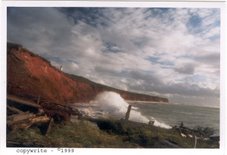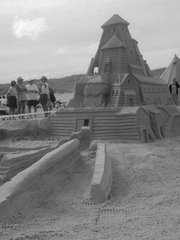This Was A Whale OF A Project!
APRIL 5, 2007 - 10:30 ET
Canadian Museum of Nature/Winner of 2006 Museums and Schools Partnership Award: A Whale of a Project! The Tiny Magdalen Islands Win National Award
EDS NOTE: Of special interest for Quebec and Nunavut media
OTTAWA, ONTARIO--(CCNMatthews - April 5, 2007) - An educational program that brought together 50 per cent of the youth on the Magdalen Islands with their local aquarium for a project on marine mammals has won the fourth annual Museums and Schools Partnership Award. This national award is co-sponsored by the Canadian College of Teachers and the Canadian Museum of Nature, in collaboration with the Canadian Museums Association. An honourable mention was awarded to a collaboration between a school and community museum in Sanikiluaq, located in Nunavut's Belcher Islands in the south-eastern area of Hudson Bay.
The idea for the marine mammal project was conceived in 2003 when a minke whale was found on the shore of one of these islands, located in the Gulf of St. Lawrence. The community pulled together to remove it. Due to the amount of work involved, it was thought that the involvement of youth would greatly benefit the project. Out of this came a partnership between the Aquarium des Iles-de-la-Madeleine, the school board (la Commission scolaire des Iles-de-la-Madeleine) and the CÉGEP (le campus des Iles du CÉGEP de la Gaspésie-Iles de la Madeleine). It culminated three years later in an exhibition about the marine mammals they had collected. Every stage of the project depended on youth participation, even the flensing (cutting up) of the specimens and the mounting of skeletons.
The diverse range of activities included art contests, a competition to name new seals at the aquarium, a debate in Montreal on the seal hunt, visits to a CÉGEP biology class, drawing workshops, a lecture on marine mammals hosted by secondary students, the creation of interpretive panels for the exhibition, and the mounting of a harbour porpoise skeleton by biology students. The exceptional quality of these activities was noted by the selection committee.
"Another important facet was the participation of the community in enriching this project,"noted Mary Ellen Herbert, co-chair of the award committee, in summing up the comments of the judges. "Visitors benefit not only from a scientific exhibition on marine mammals but also from the perspectives of island youth about their natural heritage. The fact that the Aquarium gave the young people a chance to engage in activities that spoke to their reality and environment gave them ownership of these themes. Further, they could discuss these issues with their parents and friends and enhance community knowledge."
"We're very, very happy about this recognition", says Aquarium director Sophie Fortier, noting the great benefit for the community that results when museums and schools work together.
An honourable mention for the 2006 Museums and Schools Award was given to a partnership with the Najuqsivik Society Community Museum which is housed in Nuiyak School in Sanikiluaq, a community of 800 people.
Students were involved in projects as diverse as making archaeological castings, polar bear rugs and mounts, helping to finish a sod house, videoconferencing and more. As John Jamieson, principal of the Nuiyak School stated: "The foyer of the school is the static museum but the real action of the museum is the hands-on activities that produce these artifacts. Some of our programs will not be found in any other northern school."
The method of archaeological reproduction casting, which the students learned at the Archaeological Survey of Canada labs in Gatineau, Quebec, has resulted in over 160 moulds. The community has also produced videos on this casting process in both English and Inuktitut and has given workshops.
Submissions from across the country, involving more than 20 institutions, were entered for the 2006 award, which recognizes partnerships between schools and museums for educational programmes that enrich students' understanding and appreciation of Canada's cultural and natural heritage. Criteria for assessing projects include vision, participation of all partners from the outset, collaboration potential and relevance of the project to the community served.
The Museums and Schools Partnership Award is open to any Canadian school or school board that collaborates with any Canadian non-profit public museum, including zoos and science centres. The submission deadline for the 2007 award is Nov. 15, 2007. The Canadian Teachers' Federation has joined the sponsoring partnership and will be involved in the organization and selection processes for next year's award. For more information, visit the Web site of the Canadian College of Teachers at www.cct-cce.com.
Canadian Museum of Nature/Winner of 2006 Museums and Schools Partnership Award: A Whale of a Project! The Tiny Magdalen Islands Win National Award
EDS NOTE: Of special interest for Quebec and Nunavut media
OTTAWA, ONTARIO--(CCNMatthews - April 5, 2007) - An educational program that brought together 50 per cent of the youth on the Magdalen Islands with their local aquarium for a project on marine mammals has won the fourth annual Museums and Schools Partnership Award. This national award is co-sponsored by the Canadian College of Teachers and the Canadian Museum of Nature, in collaboration with the Canadian Museums Association. An honourable mention was awarded to a collaboration between a school and community museum in Sanikiluaq, located in Nunavut's Belcher Islands in the south-eastern area of Hudson Bay.
The idea for the marine mammal project was conceived in 2003 when a minke whale was found on the shore of one of these islands, located in the Gulf of St. Lawrence. The community pulled together to remove it. Due to the amount of work involved, it was thought that the involvement of youth would greatly benefit the project. Out of this came a partnership between the Aquarium des Iles-de-la-Madeleine, the school board (la Commission scolaire des Iles-de-la-Madeleine) and the CÉGEP (le campus des Iles du CÉGEP de la Gaspésie-Iles de la Madeleine). It culminated three years later in an exhibition about the marine mammals they had collected. Every stage of the project depended on youth participation, even the flensing (cutting up) of the specimens and the mounting of skeletons.
The diverse range of activities included art contests, a competition to name new seals at the aquarium, a debate in Montreal on the seal hunt, visits to a CÉGEP biology class, drawing workshops, a lecture on marine mammals hosted by secondary students, the creation of interpretive panels for the exhibition, and the mounting of a harbour porpoise skeleton by biology students. The exceptional quality of these activities was noted by the selection committee.
"Another important facet was the participation of the community in enriching this project,"noted Mary Ellen Herbert, co-chair of the award committee, in summing up the comments of the judges. "Visitors benefit not only from a scientific exhibition on marine mammals but also from the perspectives of island youth about their natural heritage. The fact that the Aquarium gave the young people a chance to engage in activities that spoke to their reality and environment gave them ownership of these themes. Further, they could discuss these issues with their parents and friends and enhance community knowledge."
"We're very, very happy about this recognition", says Aquarium director Sophie Fortier, noting the great benefit for the community that results when museums and schools work together.
An honourable mention for the 2006 Museums and Schools Award was given to a partnership with the Najuqsivik Society Community Museum which is housed in Nuiyak School in Sanikiluaq, a community of 800 people.
Students were involved in projects as diverse as making archaeological castings, polar bear rugs and mounts, helping to finish a sod house, videoconferencing and more. As John Jamieson, principal of the Nuiyak School stated: "The foyer of the school is the static museum but the real action of the museum is the hands-on activities that produce these artifacts. Some of our programs will not be found in any other northern school."
The method of archaeological reproduction casting, which the students learned at the Archaeological Survey of Canada labs in Gatineau, Quebec, has resulted in over 160 moulds. The community has also produced videos on this casting process in both English and Inuktitut and has given workshops.
Submissions from across the country, involving more than 20 institutions, were entered for the 2006 award, which recognizes partnerships between schools and museums for educational programmes that enrich students' understanding and appreciation of Canada's cultural and natural heritage. Criteria for assessing projects include vision, participation of all partners from the outset, collaboration potential and relevance of the project to the community served.
The Museums and Schools Partnership Award is open to any Canadian school or school board that collaborates with any Canadian non-profit public museum, including zoos and science centres. The submission deadline for the 2007 award is Nov. 15, 2007. The Canadian Teachers' Federation has joined the sponsoring partnership and will be involved in the organization and selection processes for next year's award. For more information, visit the Web site of the Canadian College of Teachers at www.cct-cce.com.





No comments:
Post a Comment